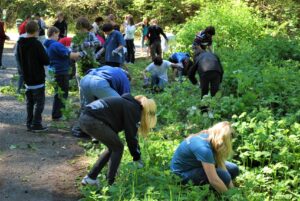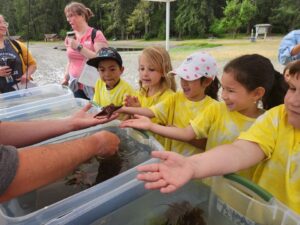Robert More’s 6th-grade students had questions.
Who made the bat havens?
What connections are there between the factories next door and Steigerwald?
What even is a wetland?
How does the restoration impact the Columbia River/greater ecosystem?
Why geese?
Their Odyssey Middle School class was visiting Steigerwald Lake National Wildlife Refuge, but this was not a field trip. It was a ‘High Impact

Field Experience’ or HIFE. HIFEs are designed to maximize the positive impact of field experiences by incorporating learning goals, locations and community partners. More and his colleague, 6th-grade science teacher Karen Motsinger, were two of 63 teachers who attended PEI’s two-part HIFE workshop in October. Odyssey Middle School is a project-based campus in Camus, Washington.
Steigerwald Lake NWR was established in 1987 to reduce the impact of lowland habitat loss for migrating and resident wildlife due to construction at the Bonneville dam. Over the past two decades smaller pieces of land have been restored and added to the refuge. More and Motsinger’s classes visited one of the most recently restored sites and considered ‘SPREE’ factors – social, political, religious, economic and environmental factors that might have impacted the project in relation to the science standard of understanding human impact on the environment.
“HIFEs inspire teachers to rethink their strategies for engaging students in ways that feel meaningful,” says South Sound FieldSTEM Coordinator Lara Tukarski, one of the workshop’s facilitators. “While they may take a little bit more energy than just doing a field trip, the impact is visible in terms of how the students respond. There’s a shift in the system.”
“I have planned trips for students for years; this experience allowed me to look at what I plan for my students differently.”
— HIFE Cohort Participant
At the first, statewide session, Clare Sobetski of the Washington State Department of Natural Resources shared ways teachers can collaborate with community partners to design a HIFE. Between sessions, participating educators chose one aspect of the HIFE such as a field journal to develop. They shared those projects at the second session and broke into regionally specific groups.
For the first time, PEI also facilitated a cohort of six teachers within the larger group who committed to implementing a HIFE with their students and sharing what they learned. PEI helped one educator in Spokane connect with the Spokane Tribal Fisheries Department to build a project for his fourth graders; another is talking with the Washington State Department of Fish & Wildlife about the role of culverts in salmon recovery within Grays Harbor County.
Cohort participants have proven to be a valuable resource for each other, says PEI’s Lower Columbia FieldSTEM Coordinator Emily Newman. “There were a couple of times when a teacher shared how they were doing a specific field experience and another teacher would say, ‘I love that idea. I’m changing mine to the same thing.’ They could make those connections and modifications based on what they learned from each other.”

Questions are a central focus of HIFEs and the emphasis is on exploring together rather than the teacher having all the answers. “It’s affirming for teachers to expand their thinking and reimagine their teaching practice,” says Tukarski. “They have an opportunity to explore doing things a different way, even when they’re not sure what the outcomes are going to be.”
HIFE workshops help teachers gain confidence, according to their evaluations. “I have planned trips for students for years; this experience allowed me to look at what I plan for my students differently,” one participant reported. “Creating a field experience isn’t as daunting as I expected,” said another.
One teacher noted that HIFEs engage students who are not inspired by traditional classroom environments. “She works with diverse learners, and the focus of her group has not typically been through the lens of science,” Tukarski explains. “There are Social and Emotional Learning (SEL) and equity threads when you design a teaching practice this way. It works with different learning strengths.”
PEI will be offering a statewide HIFE workshop as part of its spring introductory course series.
